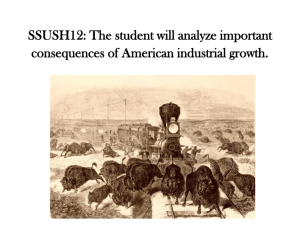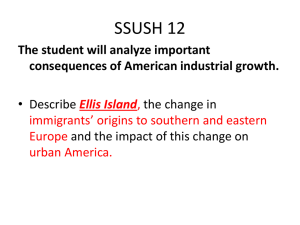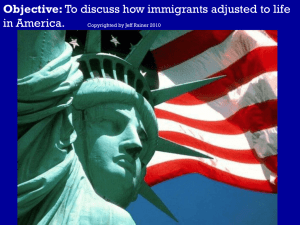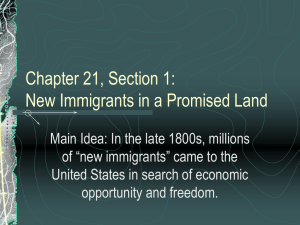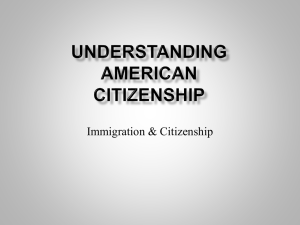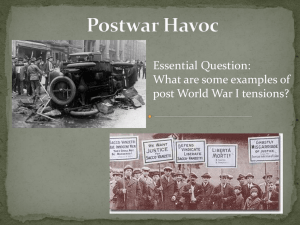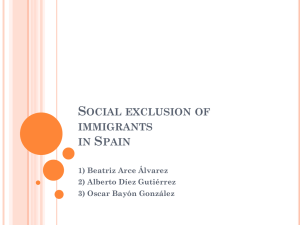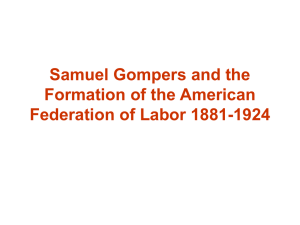Document
advertisement
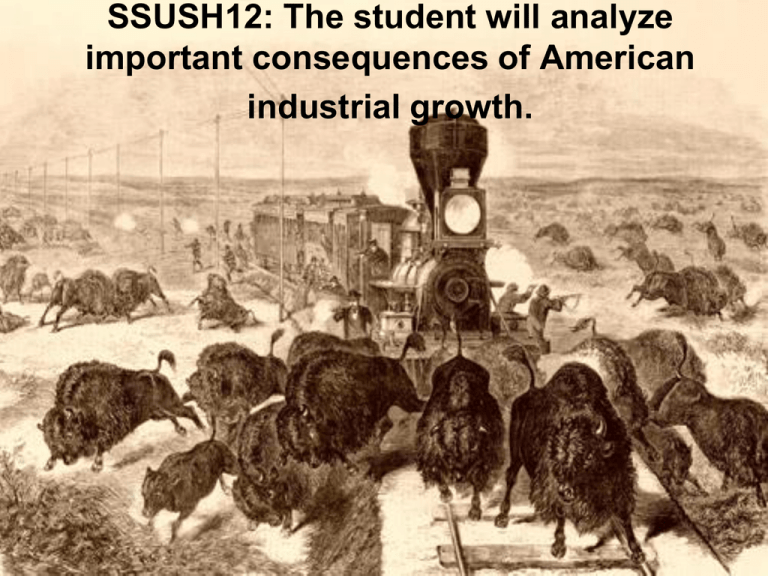
SSUSH12: The student will analyze important consequences of American industrial growth. Bell Ringer • Examine this political cartoon: 1. What is the theme? 2. What is the message that the artists wishes to convey? 3. Do you agree with the message? Essential Questions 5&6 1. How did the shift of immigrant origins affect urban America? What role did Ellis Island play in immigration? 2. What caused the rise in labor consciousness in the late 1800’s and early 1900’s? Include an explanation of the AFL [American Federation of Labor], Samuel Gompers and the Pullman strike. • Use the following notes to complete the handouts given • Use your textbook if needed a. Describe Ellis Island, the change in immigrants’ origins to southern and eastern Europe and the impact of this change on urban America. • Ellis Island (NY) was the entry point for many European immigrants • Immigrants had to pass medical, mental, and legal exams and have at least $25 in order to enter into the U.S. European Immigration • Up until the 1880s most European immigrants came from Northern and Western Europe (Ireland, England, Germany). Many of these “looked” like Americans, and had similar religious and cultural backgrounds • Beginning in the late 1880s, a change began to occur in the origin of immigrants. These “new” immigrants began arriving from eastern and southern Europe (Italy, Greece, Poland, Russia). The “New” Immigrants • Many of these new immigrants didn’t speak English, came from non democratic governments, had differing religions, and didn’t “look” American. The “New” Immigrants • These new immigrants often settled together in east coast cities (Little Italy), and worked in low paying factory jobs • This new wave of immigrants caused the emergence of nativism: an extreme dislike of immigrants Why would these new immigrants want to settle together in cities? Ellis Island Immigrants Registry Room Registry Room Today Ellis Island d. Describe the 1894 Pullman strike as an example of industrial unrest. • Pullman was a railroad car company. – Workers lived in Pullman owned homes – Pullman Company laid off 3,000 of 5,800 workers – Cut wages 25-50 percent, didn’t cut the rents in the company town – American Railway Union (led by Debs) began strike, which turned violent – Strikebreakers were hired – Pres. Cleveland sent in federal troops to end the strike d. Describe the 1894 Pullman strike as an example of industrial unrest. • In 1894 the American Railway Union, led by Eugene Debs, led a strike against the Pullman Company (IL) who manufactured railroad cars • President Cleveland sent in U.S. troops and ordered the strike to end. • The ARU collapsed as a Union as a result of government intervention b. Identify the American Federation of Labor and Samuel Gompers. • American Federation of Labor (AFL) - 1886 – Skilled workers only, smaller membership – Used collective bargaining and strikes – Some success with higher wages and shorter work weeks – Still exists today as AFL-CIO – Founded by Samuel Gompers • The AFL is still in existence today As the AFL-CIO c. Describe the growth of the western population and its impact on Native Americans with reference to Sitting Bull and Wounded Knee. • Americans moved westward in the 1860s to become ranchers, miners, and farmers. • The settlers began to encroach on Native American hunting grounds and broke numerous treaties How would fences that were constructed by farmers and ranchers affect Native Americans? Joining of the Transcontinental RR (May 10, 1869) c. Describe the growth of the western population and its impact on Native Americans with reference to Sitting Bull and Wounded Knee • RR make it easier for people to move west (transcontinental Railroad - 1869) • Gov’t gives money and land grants to RRs • Lifestyle of the Plains Indians is threatened: – Nomadic – move from place to place – Buffalo is important to life • Settlers destroy buffalo population – From 15 million in 1865 to 600 in 1886 Wounded Knee • By the late 1880s most western Indian tribes had been resettled onto reservations • Sitting Bull, a Sioux Chief, who helped defeat Custer at the Little Big Horn, had moved onto a reservation and began performing the “Ghost Dance” which his followers believed would bring back the buffalo, and make the settlers disappear • Sitting Bull is ordered to stop, but refuses and is killed while being arrested Wounded Knee • Many of Sitting Bulls followers fled the reservation after his death and camped at Wounded Knee Creek with other Sioux • The U.S Calvary, which was sent to escort the Sioux back to the reservation, attempted to disarm them and a fight broke out Wounded Knee • In the massacre that followed, nearly 200 Sioux men, women and children were killed • Many of the injured froze to death • Wounded Knee led many to question the treatment of Native Americans, and was the last major resistance by Native Americans Chief Big Foot’s Body Wounded Knee, SD, 1890
